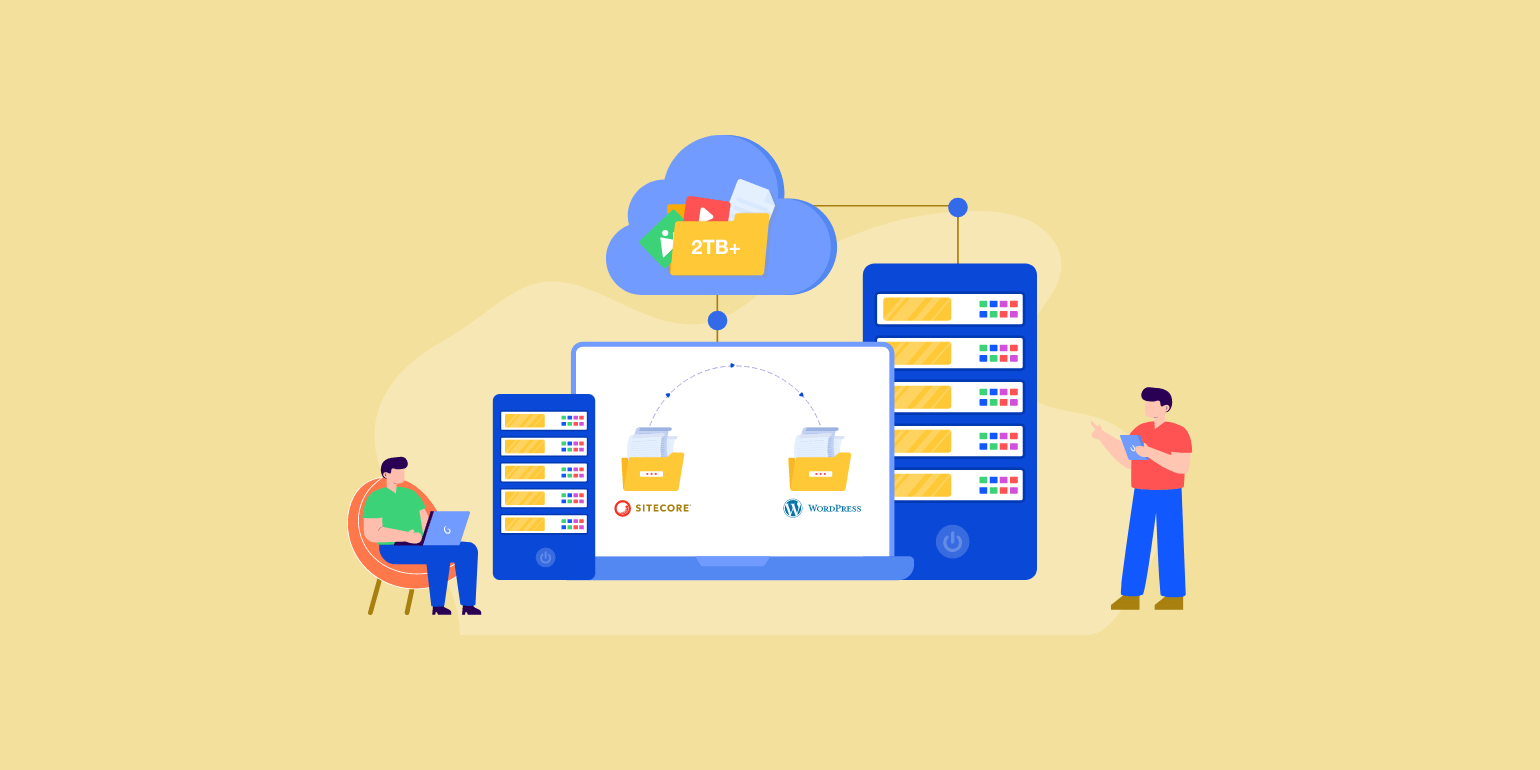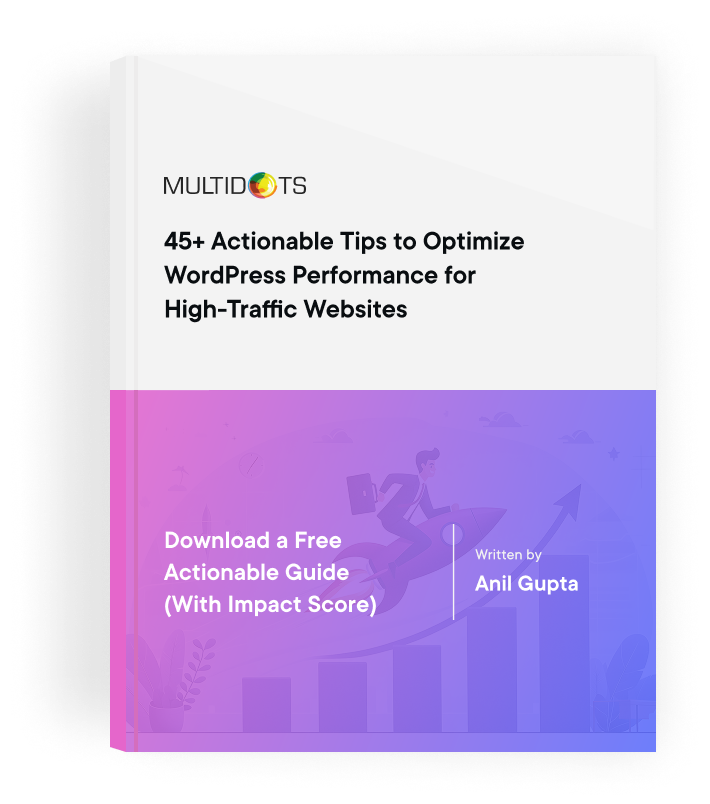Challenges Enterprises Face While Moving From Sitecore to WordPress: A Guide on Moving 2TB+ Data
Identify the 7 key challenges enterprises may encounter when migrating over 2TB of data from Sitecore to WordPress

Table of Contents
As WordPress offers a more agile, cost-effective, and user-friendly environment, more enterprises are shifting towards WordPress as their CMS of choice, moving away from legacy platforms like Sitecore. The flexibility and scalability of the WordPress platform make it particularly attractive for enterprise-level organizations.
However, migrating a large Sitecore site to WordPress — especially when dealing with 2TB+ of data — is not without its obstacles. Failing to anticipate these challenges can jeopardize not only the migration project but also your business operations. There are also potential hidden costs associated with WordPress migrations, such as unexpected expenses for plugins, security enhancements, or customization requirements.
Understanding these challenges while leveraging Sitecore to WordPress migration services can save you time, money, and endless headaches. When planning the shift to WordPress, it is crucial to evaluate enterprise WordPress hosting options to ensure your new environment can handle scalability, security, and performance needs for large-scale migrations.
In this article, let’s look at the seven challenges you might encounter during the migration of large Sitecore data to WordPress and how to navigate them effectively, especially considering the complexity of WordPress migrations for enterprises moving from Sitecore.
Introduction to Migration
Migrating a website from Sitecore to WordPress is a significant undertaking, especially for enterprises managing vast amounts of data and complex digital assets. However, with the right migration process, this transition can be a strategic move to enhance your digital presence and streamline content management.
WordPress stands out as a leading content management system, renowned for its user-friendly interface and extensive customization options. Whether you’re looking to improve content creation workflows, leverage a wide array of plugins, or simply make your site more accessible to non-technical users, WordPress offers the flexibility and scalability needed for modern enterprise sites.
In this guide, we’ll walk you through the essential steps and best practices to ensure a successful migration, helping you unlock the full potential of your new WordPress site.
Understanding Sitecore and WordPress
Before embarking on the migration process, it’s important to understand the fundamental differences between Sitecore and WordPress. Sitecore is a proprietary CMS built for enterprise-grade organizations, offering advanced features such as personalized content delivery, robust marketing automation, and comprehensive digital asset management. These capabilities make Sitecore a powerful digital experience platform for businesses with complex needs.
In contrast, WordPress is an open-source platform celebrated for its extensive customization and scalability, making it suitable for organizations of all sizes. For enterprises seeking additional support and security, WordPress VIP provides a managed hosting solution with enterprise-grade features, including enhanced security, scalability, and dedicated support.
By understanding these distinctions, you can better plan your migration and ensure your new WordPress site meets your organization’s requirements for advanced features and seamless digital experiences.
Cost and Resource Considerations
Cost is often a driving factor behind the decision to migrate from Sitecore to WordPress. Maintaining a proprietary CMS like Sitecore can be costly, particularly for enterprises with expansive digital marketing operations and the need for ongoing custom development.
WordPress, by comparison, offers a more budget-friendly approach, with lower licensing fees and access to a vast ecosystem of affordable themes and plugins. However, a successful migration requires more than just switching platforms—it demands careful allocation of resources, including time, technical expertise, and thorough testing to ensure all content and functionality are transferred correctly.
By planning ahead and leveraging WordPress’s flexibility, businesses can not only reduce operational costs but also create a seamless, personalized digital experience that supports their marketing goals and drives engagement. Careful consideration of both the costs and the resources involved will help ensure your migration delivers long-term value for your enterprise.
1. Content Mapping
Content mapping involves identifying what content stored in the Sitecore database will go where within your new WordPress environment. Without a well-planned content map, the entire migration process can become disorganized and lead to potential data loss. It is also crucial to plan for the migration of media assets from the Sitecore media library to the WordPress media library to ensure all files are transferred and accessible post-migration.
When you’re dealing with a hefty amount of data — say, 2TB or more — the challenge amplifies.
The sheer volume makes it more complicated to manage, and the probability of overlooking critical content increases.
Moreover, if you’re migrating Sitecore to Enterprise WordPress, you have to be doubly sure that all enterprise-specific functionalities and content types are accurately mapped. For organizations that manage multiple sites or require robust multi site management, it’s essential to consider how these capabilities will be handled in the new environment during the content mapping process.
Failing to address this challenge effectively can lead to issues like:
- Incomplete or disorganized content transfer, leading to operational inefficiencies.
- Potential loss of vital data, affecting business continuity.
- Increased migration time, causing stakeholder dissatisfaction and lost opportunities.
Here are a few things you can do to handle this challenge:
- Create a comprehensive pre-migration checklist, outlining every content type and where it will be placed in WordPress.
- If feasible, perform a smaller test migration first to identify any issues that could arise when handling the entire 2TB+.
- Leverage automation tools or custom scripts to streamline the content mapping process, ensuring the efficient migration of the Sitecore database to WordPress.
- Consult professionals experienced in Enterprise WordPress as CMS to guide you through the specifics of content mapping for enterprise-grade requirements, including the unique needs of Sitecore users who manage complex site structures or multiple sites.
2. Downtime during the Migration Process
One of the most significant Sitecore to WordPress migration challenges is minimizing downtime.
This issue is particularly tricky because you’re transferring a vast amount of data, sometimes over 2TB, from one platform to another. Downtime not only disrupts user experience but can also have a ripple effect on your business operations. For high traffic enterprise sites, even brief downtime can result in substantial revenue loss and damage to brand reputation, making robust planning and infrastructure essential.
This can lead to:
- Loss of revenue due to reduced site availability.
- Decline in user trust and satisfaction, affecting brand reputation.
- SEO penalties for website unavailability or broken links.
Keep these tips handy to go through this roadblock:
- Include a well-thought-out plan for minimizing downtime in your pre-migration checklist.
- Perform the migration during off-peak hours to lessen the impact on users and operations.
- Use incremental data migration methods to keep the website partially operational during the transition.
- Coordinate closely with your hosting provider to ensure your infrastructure can handle the migration process and any temporary spikes in load, especially for high traffic sites.
3. SEO Preservation Issues
When moving from Sitecore to WordPress, especially when it involves 2TB+ data, it can be difficult to maintain the SEO metadata, URL structures, and other elements critical to your search engine ranking. It’s essential to preserve the seo value of high-performing content during migration to ensure continued visibility and traffic.
Furthermore, there’s more room for error, like failing to properly redirect URLs or losing vital metadata. Plus, both CMS platforms handle SEO-related features differently, requiring additional planning.
When your site’s search-engine friendliness isn’t preserved properly, you can expect:
- Sudden drop in search engine rankings, reducing your visibility in search engines.
- Loss of organic traffic, leading to reduced revenue.
- Broken links and 404 errors, affecting user experience and SEO.
You can navigate this challenge and protect your rankings by following these best practices:
- Make SEO preservation a priority in your pre-migration checklist.
- Use plugins or manual methods to move SEO metadata while migrating the Sitecore database to WordPress.
- Conduct a detailed SEO audit both before and after the migration to keep tabs on any fluctuations.
4. Custom Functionalities and Integrations
Both platforms have unique ways of handling custom modules, plugins, and API integrations. During a large-scale migration involving 2TB+ data, each custom functionality needs to be individually assessed and migrated, a process that is both time-consuming and complex. It is important to identify which Sitecore features can be replicated using WordPress plugins or third party software, considering the impact on the entire site and the potential need for advanced functionality.
In simpler terms, you’re not just moving content; you’re also transferring unique functionalities that may have been tailored specifically for your enterprise in Sitecore.
Errors while setting up these additional integrations can lead to:
- Loss of essential functionalities, affecting workflows.
- Potential security vulnerabilities due to incompatible or outdated plugins.
- Unexpected operational disruptions due to failed integrations.
- Lack of seamless integration may prevent the entire site from functioning as expected after migration.
These tips will help you ensure your new WordPress website’s functionalities meet your enterprise’s needs:
- Begin by cataloging all custom functionalities and integrations as part of your pre-migration checklist.
- Evaluate and select premium plugins to achieve advanced functionality and ensure robust, enterprise-level performance.
- Test each functionality in a WordPress staging environment before implementing it on your live site.
- Post-migration, perform extensive testing to confirm that all custom functionalities and integrations work as expected in WordPress as an enterprise CMS.
5. Enterprise Security, Security Vulnerabilities, and Compliance
Sitecore and WordPress differ fundamentally in their approaches to security protocols and compliance standards. When migrating a large Sitecore database to WordPress, especially one that exceeds 2TB, you’re not just transferring data but, sometimes, also inheriting the security features or potential vulnerabilities from the old platform.
Moreover, as enterprises have a large number of teams and stakeholders, moving the user authentication details can also get tricky. Whether it is maintaining the accuracy of credentials, handling user permissions, or protecting organizational data, each additional data point increases the chances of mistakes. In particular, customer data collected and stored within Sitecore may be exposed during migration if not properly secured, making it essential to ensure the protection of customer data both during and after the migration process.
Security vulnerabilities for WordPress enterprises can result in:
- Potential exposure of sensitive data, leading to legal repercussions.
- Non-compliance with industry or governmental regulations, attracting hefty fines.
- Loss of customer trust due to compromised security features.
Fortunately, there are ways in which you can tackle this:
- Conduct a security audit as part of your pre-migration checklist to identify any vulnerabilities.
- Ensure that your enterprise WordPress CMS migration plan from Sitecore includes strategies to achieve compliance with industry-specific regulations.
- Utilize enterprise-level security plugins that are compatible with WordPress as an enterprise CMS.
- Continuously monitor for any security vulnerabilities post-migration and update security protocols as needed.
6. Team Training and Adoption
Your team has likely spent years getting comfortable with Sitecore and switching to a new platform like Enterprise WordPress can bring about a steep learning curve. However, WordPress’s intuitive interface, including features like the Gutenberg Block Editor and full-site editing, can significantly reduce the time needed for team members to become proficient with the new platform.
This challenge is magnified when you’re dealing with a large Sitecore database moving to WordPress, which entails understanding new data structures, workflows, and functionalities.
Unfamiliarity with the WordPress CMS can lead to:
- Reduced efficiency due to unfamiliarity with the new system.
- Increased potential for mistakes that could compromise data integrity.
- Low morale among team members, leading to decreased productivity.
You can make the WordPress adoption for your team easier by:
- Initiate training sessions well before the actual migration. Include a comprehensive checklist that details the skills needed for the new platform.
- Check out WordPress.org Support Forums, Learn WordPress Online Workshops, and Digital Point WordPress Forum to find relevant information and support.
- Set up a sandbox environment to allow team members to practice and experiment with Enterprise WordPress as a CMS, without affecting live data.
7. Post-migration Adjustments
Even after a successful migration, the work isn’t quite over. Post-migration adjustments are a critical aspect of the Sitecore to WordPress migration challenges you may face.
When you’re moving 2TB+ of data, these adjustments can be complex. Data might have been altered or lost in the migration, custom functionalities might not perform as expected, and you might discover unforeseen issues requiring immediate fixes.
Not investing in these fixes can result in:
- Unforeseen performance bottlenecks affecting user experience.
- SEO rankings may suffer despite the best marketing efforts.
- Incomplete or incorrect data may compromise business operations.
Here is how you can approach post-migration edits after the transition:
- Conduct a thorough review of all migrated content against a pre-migration checklist to ensure data integrity and completeness.
- Keep a rollback plan ready. If issues are too significant, reverting to the Sitecore database can buy you time to correct the problems before going back to WordPress.
- Keep a close eye on website performance metrics and track user behavior after moving to WordPress to identify areas of improvement before they start affecting your business workflows.
- Engage your team in testing all custom functionalities and integrations. Make the necessary code adjustments or reconfigurations.
Wrapping Up
We’ve walked you through the seven key Sitecore to WordPress migration challenges, particularly when you’re moving a hefty 2TB+ of data.
From tackling content mapping issues to ensuring a seamless post-migration adjustment, it’s clear that being prepared is half the battle won. That will make your migration process as smooth as possible by minimizing mistakes and following the best practices.
However, navigating these challenges while going through all the phases of Sitecore to WordPress migration can get daunting for enterprises.
We, at Multidots, specialize in providing robust solutions for complex migrations like these. After a successful migration, enterprises can benefit from the flexibility and scalability of WordPress sites, as well as the cost-effectiveness and ease of maintenance that WordPress websites offer for ongoing operations, security, and future growth. We can help ensure your new WordPress site becomes a stable and scalable solution for your enterprise’s needs while reducing migration timelines and costs.
Ready to make your migration process seamless? Contact Us today to learn how quickly and efficiently we can help you make the transition.
References
FAQs
-
Transferring large data from Sitecore to WordPress involves hurdles like content mapping, SEO preservation, and downtime management. Ensuring enterprise security and team training are also significant concerns, particularly when you’re dealing with 2TB+ data.
-
The time needed for migrating from Sitecore to WordPress can vary widely depending on the volume of data and the complexities involved. For 2TB+ data, you might be looking at several weeks to a few months for a comprehensive migration.
-
Exporting large data from Sitecore involves the use of specialized tools and scripts. It’s crucial to have a well-thought-out pre-migration checklist to ensure data integrity and proper formatting before the move.
-
The cost of migrating from Sitecore to WordPress is not one-size-fits-all. Factors like the amount of data, custom functionalities, and required integrations can significantly impact the total expense. Always seek a customized quote for the most accurate pricing.
Feel free to schedule a quick call with our migration expert.
Contact Us
